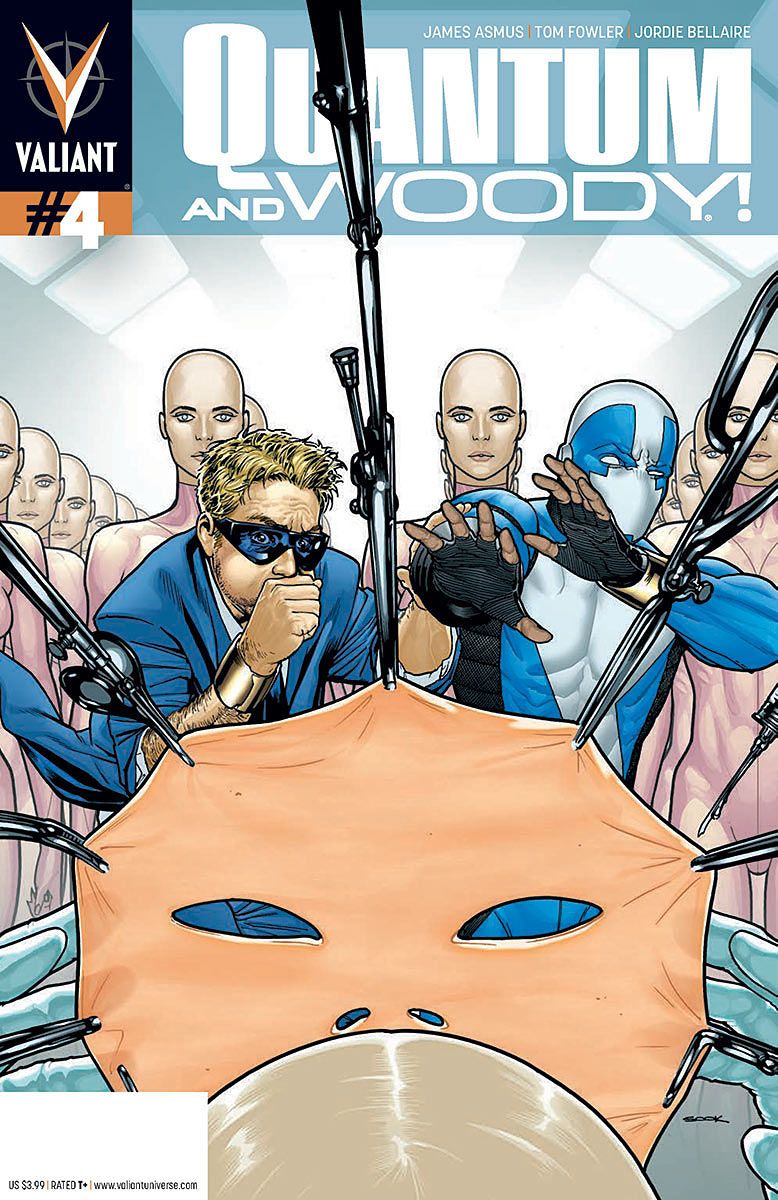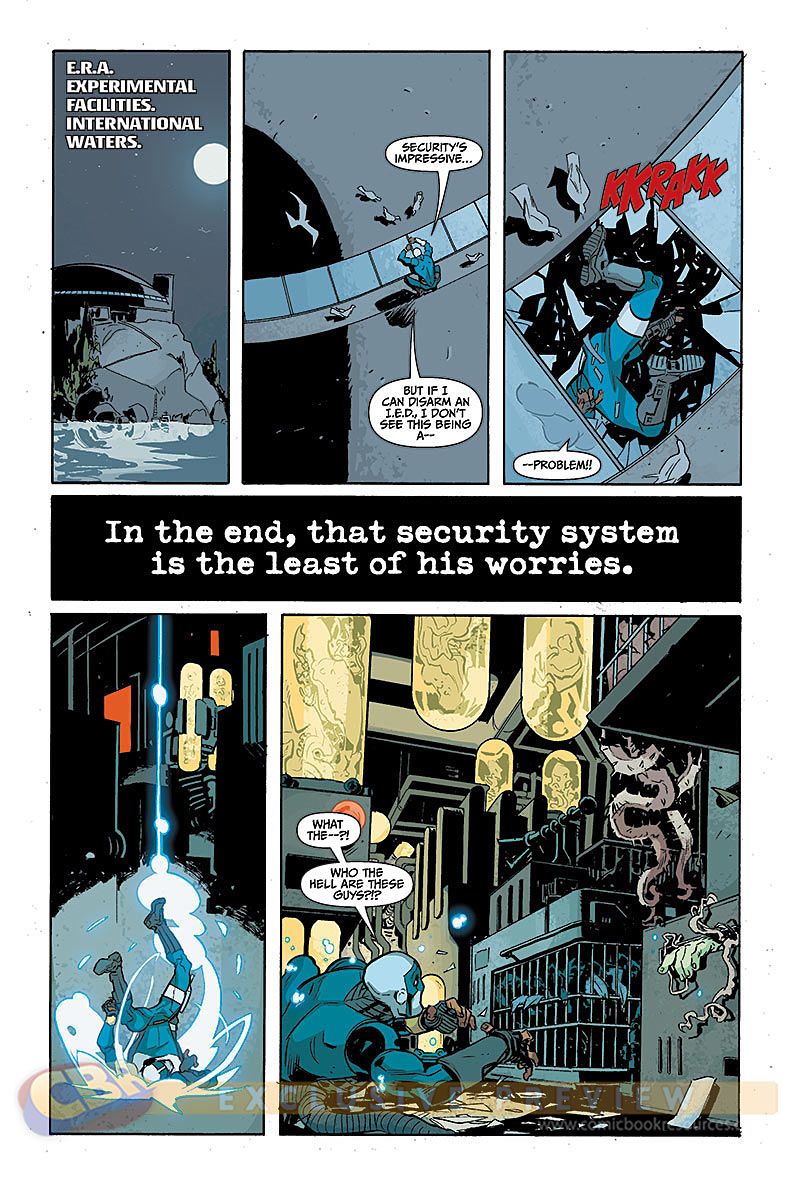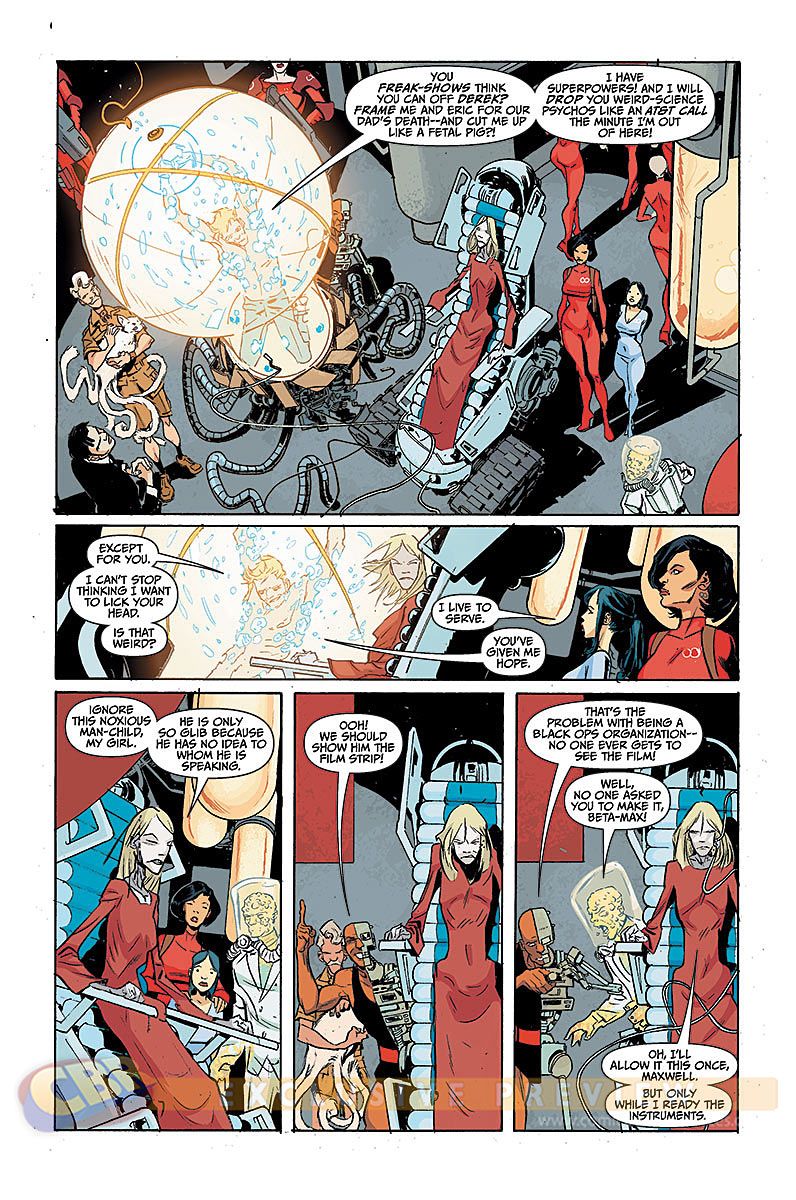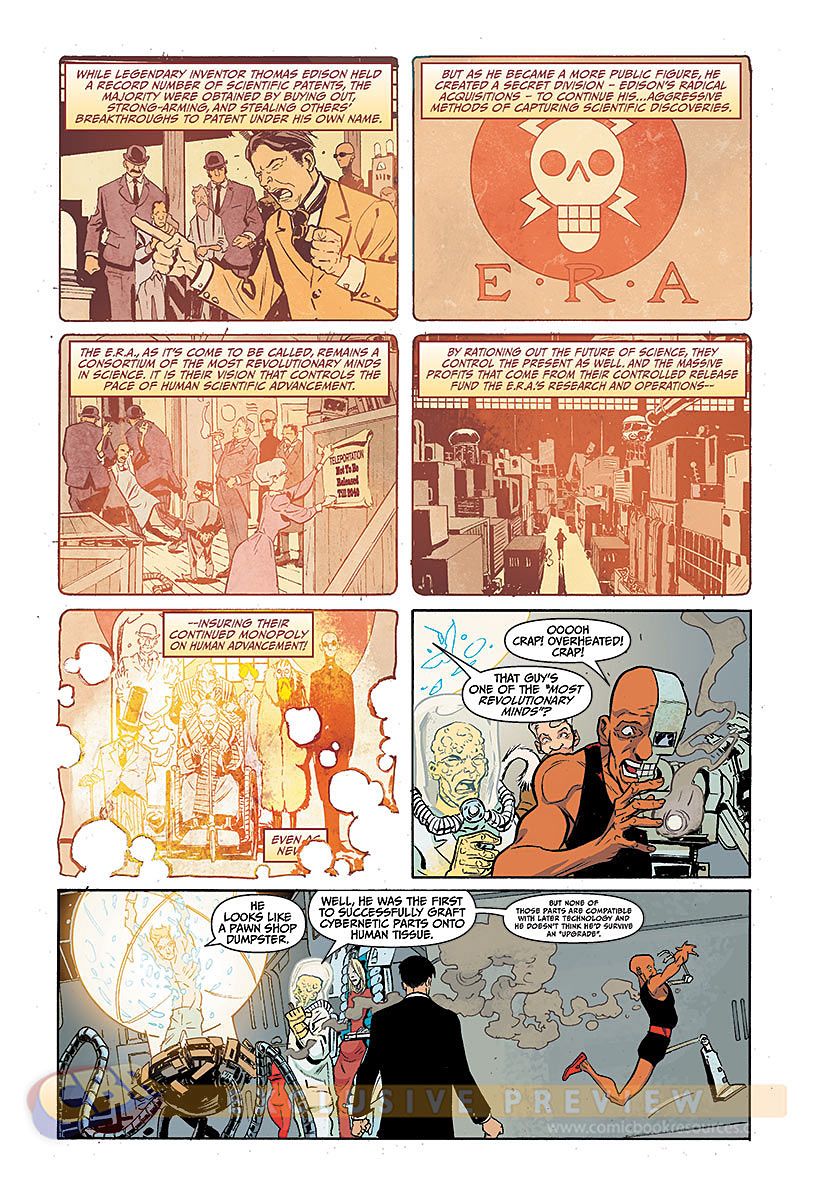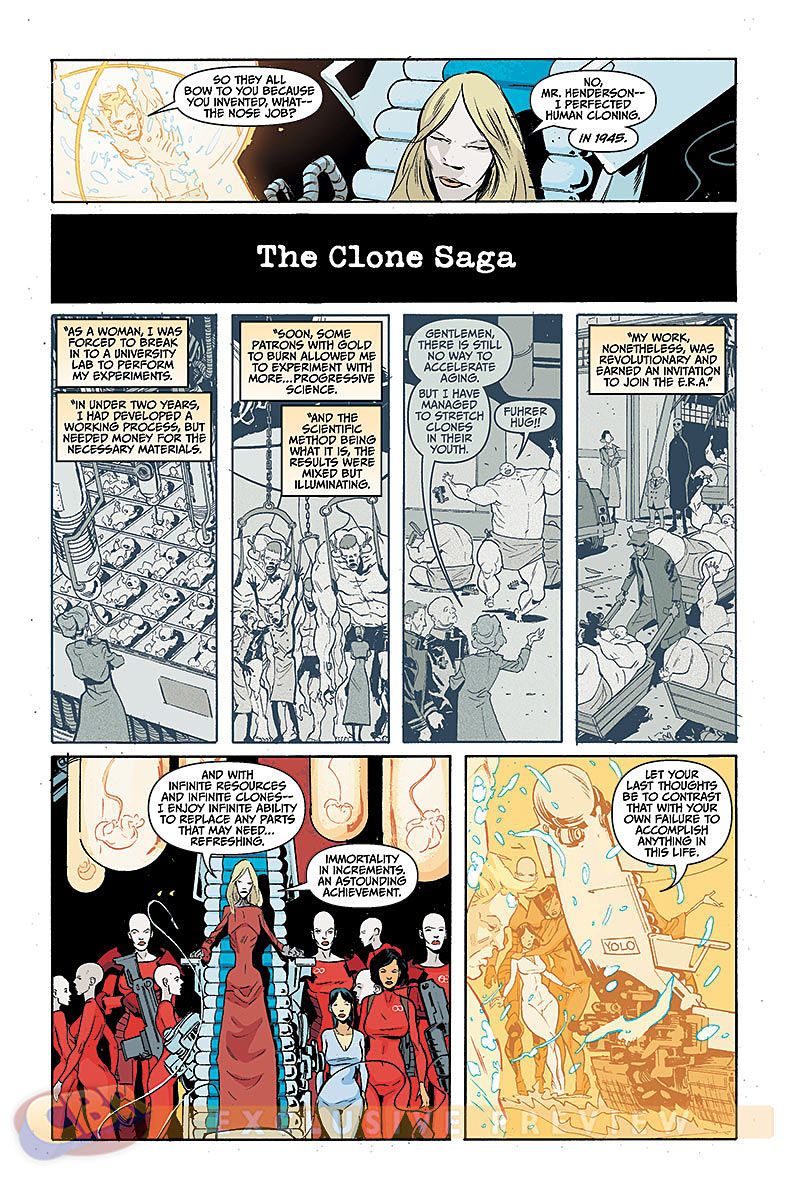At Baltimore Comic-Con 2013, Valiant Entertainment announced that "Mara" artist Ming Doyle will join "Quantum and Woody" for writer James Asmus second arc on the series in November. So far, the opening arc has revealed the Nightmare Brigade, agents from the E.R.A. and both Quantum and Woody suiting up in their signature looks -- not to mention the presence of the legendary goat. As the second arc begins in "Quantum and Woody" #5, the issue brings a secret headquarters, a slightly used hot tub, a goat and a "barely legal clone girlfriend," but Asmus hopes to focus more on character, despite some of the crazy developments.
CBR News spoke with James Asmus, Ming Doyle and incoming series editor Alejandro Arbona about the second arc, the artistic shift, drawing the incredible, insane ideas in "Quantum and Woody" and more.
Alejandro, James -- the second arc of "Quantum and Woody" has quite the first issue solicitation -- tell us a bit about where Eric and Woody find themselves at the start of the new arc. How are you going to top the ridiculousness in the first arc?
"Mara" artist Ming Doyle joins writer James Asmus on Valiant's "Quantum and Woody" #5
Alejandro Arbona: In the first arc, Quantum and Woody had an adventure. They found themselves in circumstances where they had a single adventure, but they haven't really become superheroes as such, yet. They aren't actually setting out -- they aren't making a choice to go out and be crime fighters. That's what arc two is going to be. This is where they're going to take a breather after their adventure in arc one and they're going to say, "What do we do now?" We're going to see how these ideas come up, how they figure out what they want to do with these powers, how their new lifestyle is going to affect their personalities, their characters, their way of life now that they're going to be living together. This is the arc that puts them into a position to move forward.
James Asmus: Well, my number one goal is not necessarily to top ridiculousness. I'm doing a bit of a gear-shift. It'll still be a crazy book of our guys making terrible decisions, but it starts with a bit of a breather to further some of the character stuff. Yeah, the first arc was them trying to make choices while simultaneously being victims of circumstance. When the dust settles with this life-changing chaos, this really is the time that they have to decide what they're going to make of it. In particular, this arc is going to give us a bit more opportunity to come to understand Eric and where he's coming from and his own dashed dreams and bizarre complexes he's got cooking under the surface. My main priorities were to tell a story that shows them choosing to become who they're going to be and understand Eric a little better. There are still plenty of things blowing up and poor decision-making. Probably not more weiner-touching yet, but we'll find a place to get there again.
Ming Doyle: Oh, yay! [Laughs]
Ming, this is your first issue in the Valiant Universe, and it seems like this issue will give you the opportunity to stretch a different kind of storytelling muscle. How does drawing something like the more comedic "Quantum and Woody" compare to drawing something like "Mara?"
Doyle: It's definitely going to be a huge change. "Mara" was a big leap for me, because before that project, I had never had the chance to do any sort of superhero action thing. "Quantum and Woody's" going to be my first chance to do a superhero action comedy buddy-cop type thing. It seems like I just keep adding on more things to the repertoire that I want to handle. It's going to be really different, but I'm looking forward to the opportunity to play with these characters because they're so funny. I really want to get into more physical acting with them and exploring body language, and all of that goofiness. I haven't drawn anything goofy before. This is going to be really fun. [Laughs]
Are you really looking forward to drawing the goat?
Doyle: [Laughs] I like the goat. The goat is so silly. I haven't really drawn much in the way of animals except for Rocket Raccoon, if you want to call him an animal. I don't know if that's degrading to him or not. But the goat is a nice addition. In general, I'm looking forward to drawing Quantum and Woody themselves, just because I feel like they are two archetypes that are so at the core of the comedic and dramatic experience. Quantum may as well be a drama face and Woody may as well be a comedy face.
Asmus: I love that! I absolutely love that!
Alejandro, from an editorial standpoint, what do you think makes Ming's art and James' writing a good match for "Quantum and Woody?"
Arbona: In the behind-the-scenes sense, at the story stage, it's very collaborative. If you could read the scripts, and even the e-mails we exchange, you'll see that James starts everything rolling by sending ideas, but also asking for ideas. In that regard, I think it's very important and very valuable to have an artist like Ming who is throwing things out there, having fun with it -- it's important to have an artist that has not just solid storytelling skills, but also a sense of humor and a willingness to throw in ideas and come up with what they want to see in a comic. Not just taking a script and drawing it, but what they want to see in the story from the ground up.
Ming, did you follow the original "Quantum and Woody" during its first run?
Doyle: Alas, I did not, because I was a little too into the teen dramas in the '90s when I was in middle school. I didn't read a lot of comics back then. But when the relaunch was announced, I heard about it like everybody else and I've read the beginning of the arc that Tom Fowler drew. Even without being familiar with the characters ahead of time, they're so engaging and really fun to get into that now I want to go through and read the entire original run in my free time.
In terms of the collaborative process, is there anything that you've pitched that you thought there was no way it was ever going to fly?
Doyle: Not really, because I think that's the awesome thing about comedy and specifically the sequential format -- you can get away with a lot more stuff that might be silly if you're trying to pitch it for a movie or television. You can do whatever you want with the visuals, so the sky is really the limit. When you look at some of the villains of E.R.A., they're really horrible and you would almost hate to see them in real life. But when you see them drawn on the page the way Tom portrayed them, even though they may seem like they're so unbelievable or inconceivable, they're really threatening and funny. You can do pretty much anything you can imagine in the drawing sense.
Arbona: We're looking forward to doing more of this in the future. At the moment, we haven't been going for very long. We're only just getting started. For one thing, I know when we were preparing the image that was shown with the announcement, I asked Ming to give me some sketches -- I don't think I even provided any direction at all, just show the guys and the goat. She sent back four sketches, saying, "Which one do you like?" I said, "Let's do all of them!" We're going to see them over the course of the next few months. They're hilarious.
James, how have you adjusted your collaborative process with Tom Fowler to mesh with Ming?
Asmus: I try to be as open to the input and the voice of the artist I'm working with as possible. That scales up and down based on what ways each collaborator wants to weigh in. I've worked with artists who just wanted me to send full scripts, and their single goal is to try and execute what I'm picturing as well as they can. Tom was an artist who had more ideas than we would have time to do, which is wonderful, but it was a constantly evolving process, and I was more than happy to spot the ones that I felt like really were in step with the rest of the story and find places to build those in. The book's incredibly richer and I think you can see his passion for it on the page.
Coming from theater, I always found that when you let people put in the things they want to put in, everyone is more passionate and more involved. You come to a thing that's greater and more textured than as one guy I would come up with on my own. You have more eyes looking at it from different angles. Ming and I are still pretty early in the arc of our process working together, but I've seen tremendous depth and voice and energy and passion in her work, so I'm thrilled to let her loose and let her inject her DNA into the story we're telling.
Doyle: Likewise, thank you. I really enjoyed reading your first arc of "Quantum and Woody." Really, what I'm going to bring to the project is a great respect for the story James lays down, while also knowing how I'm best at drawing and how I'm best at portraying that action. I'm also going to bring that feminine weiner-touching that the audience is calling for.
While the first arc hasn't finished yet -- and readers have yet to see the illustrious goat -- the book has certainly established its own voice and identity in Valiant's line. As the book undergoes this artistic shift, what excites you about the storytelling potential?
Doyle: Since I'm in charge of the artistic side, I'll chime in first. I'm just going to say that following Tom Fowler is going to be a gigantically intimidating Herculean task. When it comes to visual action, when it comes to comedic storytelling, Mr. Fowler I really think is probably the pinnacle. But I'm really up to it and I'm certainly going to be injecting my own storytelling sensibilities, my own character beats and the way that I handle people. I hope that even though there is an artistic shift that the characters will still be recognizable as the characters that readers have fallen in love with and gotten to know. I'm certainly going to try and draw Quantum and Woody in the spirit that Tom left them to me, if not in the exact mold.
Asmus: I do think that what I've seen in Ming's work on other projects is a fluid energy that is the spirit of the book. I feel like it taps into that same vibe that I channel when I'm writing stuff. I think there is a sensitivity to her work, particularly reading "Mara." There are small gestures between the team members that convey a genuine relationship and a kindness. Those are truly important in forging the relationship between these guys and telling the story of repairing the relationship between these characters. She brings a familiarity and emotional reality to her characters that I think is incredibly important. It's an underpinning of the book while we distract you with all the fireworks and boner jokes.
Arbona: I haven't worked here for very long, and stepping into the editor's seat in "Quantum and Woody," Tom Fowler wasn't going to be able to stay with us beyond the first arc. That was already in the cards. I thought that the challenge of replacing him, especially after he and James had given such voice and character to this launch, was really nauseating to contemplate. It really paralyzed me. I was terrified, I thought that was first big challenge. If nothing else, I think successfully landing Ming Doyle on this comic means that the first challenge is knocked out. I'm very happy with how that's gone -- now I just need to worry about the future.
James, chaos is a part of the "Quantum and Woody" identity, and that's no more apparent than in the solicits for issue #5, which tease the goat, a hot tub, a "barely-legal clone girlfriend" -- how do you find the balance between all these over-the-top ideas and grounding the next arc in character?
Asmus: Maybe it's the years I spent as an actor, but when I know what my characters' intentions are, they can be doing all these other things and going through all sorts of other motions, but still tapping into, highlighting and accomplishing something more personal. When you know someone's acting out or motivated by some emotional issues, you can tie those together and manifest them in interesting ways. That's the thing I've tried to do with the whole series so far, but in the second arc, it's coming from a slightly less combative place. There are points, like in the first issue, where they're fighting over the one containment suit -- that's a crazy, frenetic scene that's totally about their emotional relationships and identity. It's just a question of finding the right action that marries well with the character and emotional development they're trying to depict.
Arbona: "Quantum and Woody" is a comic so rich in character, but at the same time, the plotting is so fast-paced and so busy. A lot of stuff happens all the time. Issue after issue, things happen, but at the same time, there's a lot of development of character and characterization and the way these two in particular interact with each other. That sort of thing puts the lie to the misunderstanding that when something is character-based, nothing really happens; or when something is plot-based, there isn't a wealth of character. Even though you'd characterize it as a light-hearted comedy, it's a comic that shows plot and character inform each other. As James said, when you know what your characters' intentions are, good plotting is shaped by the core characters of the figures in it. I think you see that here in spades.
Asmus: I feel like the whole book is defined by trying to subvert assumptions and expectations. From its original incarnation to the reputation it had after the original run, this book was always referred to as a comedy book, which it is, but it's always been so much more. I think there's genuine commentary in it, there's genuine emotion and there's real vulnerability for these characters.
Any closing thoughts on the upcoming second arc?
Doyle: Just that I'm excited to jump in here and make some weird, fluid, funky, fun dramatic jazz that maybe is going to make people feel weird but also make them want to keep coming back for more.
Asmus: That's the best description of this book.
Doyle: It's going to be a distinctive tune, right?
Asmus: Yeah!
Doyle: All right. Let's jam.
Covers to "Quantum and Woody" #5 by Andrew Robinson & Lee Garbett and EXCLUSIVE covers to #6 by Clayton Crain & Kalman Andrasofszky
Ming Doyle joins James Asmus on "Quantum and Woody" in November with issue #5.



